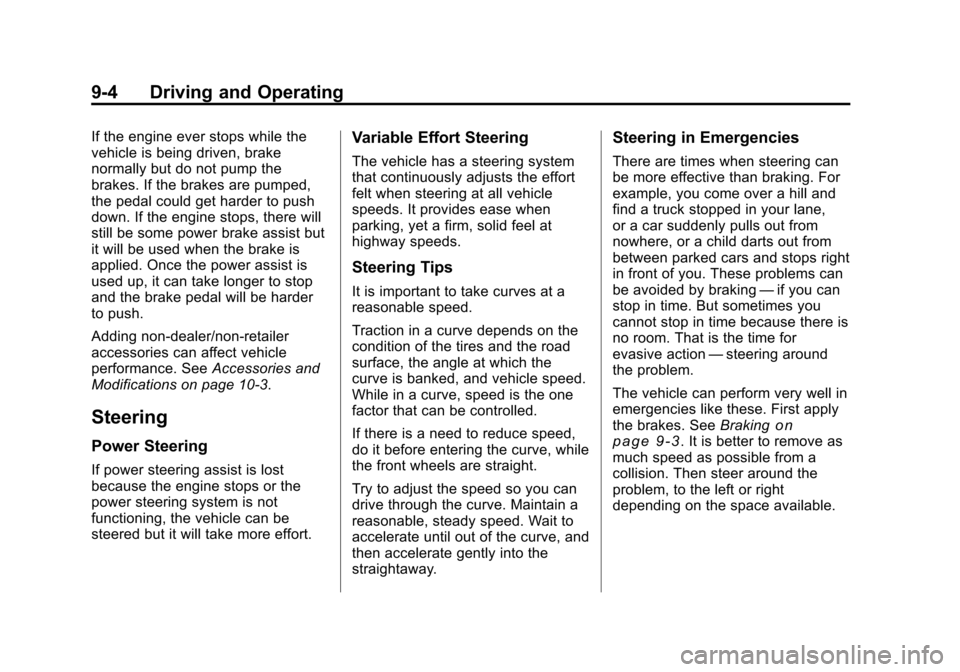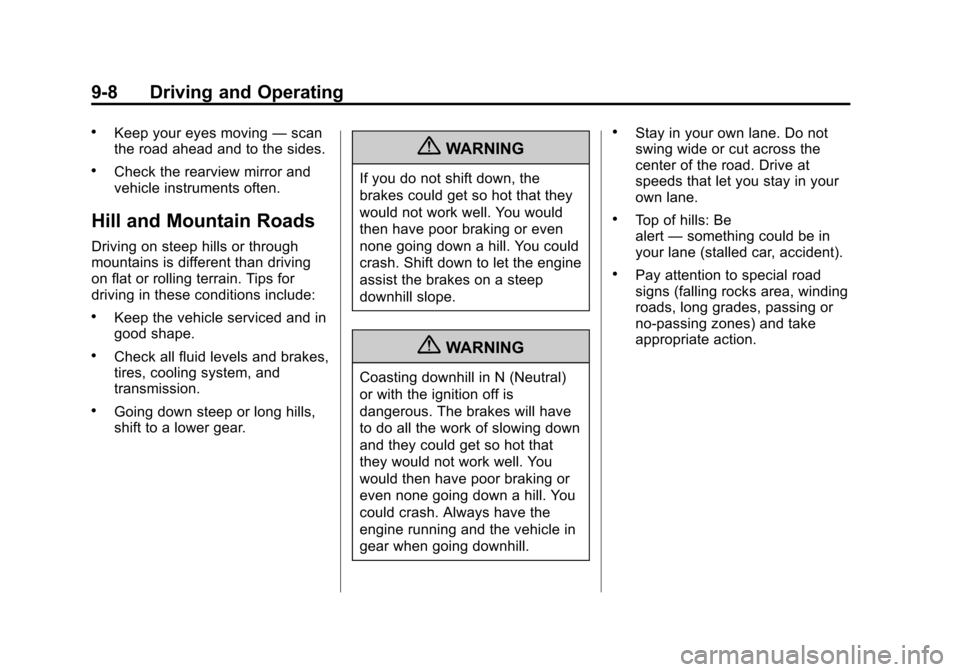lane assist CHEVROLET TRAVERSE 2010 1.G Owners Manual
[x] Cancel search | Manufacturer: CHEVROLET, Model Year: 2010, Model line: TRAVERSE, Model: CHEVROLET TRAVERSE 2010 1.GPages: 448, PDF Size: 6.96 MB
Page 256 of 448

9-4 Driving and Operating
If the engine ever stops while the
vehicle is being driven, brake
normally but do not pump the
brakes. If the brakes are pumped,
the pedal could get harder to push
down. If the engine stops, there will
still be some power brake assist but
it will be used when the brake is
applied. Once the power assist is
used up, it can take longer to stop
and the brake pedal will be harder
to push.
Adding non‐dealer/non‐retailer
accessories can affect vehicle
performance. SeeAccessories and
Modifications on page 10‑3.
Steering
Power Steering
If power steering assist is lost
because the engine stops or the
power steering system is not
functioning, the vehicle can be
steered but it will take more effort.
Variable Effort Steering
The vehicle has a steering system
that continuously adjusts the effort
felt when steering at all vehicle
speeds. It provides ease when
parking, yet a firm, solid feel at
highway speeds.
Steering Tips
It is important to take curves at a
reasonable speed.
Traction in a curve depends on the
condition of the tires and the road
surface, the angle at which the
curve is banked, and vehicle speed.
While in a curve, speed is the one
factor that can be controlled.
If there is a need to reduce speed,
do it before entering the curve, while
the front wheels are straight.
Try to adjust the speed so you can
drive through the curve. Maintain a
reasonable, steady speed. Wait to
accelerate until out of the curve, and
then accelerate gently into the
straightaway.
Steering in Emergencies
There are times when steering can
be more effective than braking. For
example, you come over a hill and
find a truck stopped in your lane,
or a car suddenly pulls out from
nowhere, or a child darts out from
between parked cars and stops right
in front of you. These problems can
be avoided by braking —if you can
stop in time. But sometimes you
cannot stop in time because there is
no room. That is the time for
evasive action —steering around
the problem.
The vehicle can perform very well in
emergencies like these. First apply
the brakes. See Braking
on
page 9‑3. It is better to remove as
much speed as possible from a
collision. Then steer around the
problem, to the left or right
depending on the space available.
Page 260 of 448

9-8 Driving and Operating
.Keep your eyes moving—scan
the road ahead and to the sides.
.Check the rearview mirror and
vehicle instruments often.
Hill and Mountain Roads
Driving on steep hills or through
mountains is different than driving
on flat or rolling terrain. Tips for
driving in these conditions include:
.Keep the vehicle serviced and in
good shape.
.Check all fluid levels and brakes,
tires, cooling system, and
transmission.
.Going down steep or long hills,
shift to a lower gear.
{WARNING
If you do not shift down, the
brakes could get so hot that they
would not work well. You would
then have poor braking or even
none going down a hill. You could
crash. Shift down to let the engine
assist the brakes on a steep
downhill slope.
{WARNING
Coasting downhill in N (Neutral)
or with the ignition off is
dangerous. The brakes will have
to do all the work of slowing down
and they could get so hot that
they would not work well. You
would then have poor braking or
even none going down a hill. You
could crash. Always have the
engine running and the vehicle in
gear when going downhill.
.Stay in your own lane. Do not
swing wide or cut across the
center of the road. Drive at
speeds that let you stay in your
own lane.
.Top of hills: Be
alert —something could be in
your lane (stalled car, accident).
.Pay attention to special road
signs (falling rocks area, winding
roads, long grades, passing or
no-passing zones) and take
appropriate action.
Page 445 of 448

INDEX i-11
Tires (cont.)Sealant and Compressor
Kit, Storing . . . . . . . . . . . . . . . . 10-61
Secondary Latch System . . . 10-70
Sidewall Labeling . . . . . . . . . . . 10-34
Terminology and
Definitions . . . . . . . . . . . . . . . . . 10-37
Uniform Tire Quality Grading . . . . . . . . . . . . . . . . . . . 10-49
Wheel Alignment and Tire Balance . . . . . . . . . . . . . . . . . . . 10-50
Wheel Replacement . . . . . . . . 10-51
When It Is Time for New Tires . . . . . . . . . . . . . . . . . . . . . . 10-46
Tow/Haul Mode . . . . . . . . . . . . . . . . 9-23
Tow/Haul Mode Light . . . . . . . . . . 5-19
Towing Driving Characteristics . . . . . . . . 9-42
Equipment . . . . . . . . . . . . . . . . . . . . 9-49
General Information . . . . . . . . . . 9-41
Recreational Vehicle . . . . . . . . 10-77
Trailer . . . . . . . . . . . . . . . . . . . . . . . . 9-46
Vehicle . . . . . . . . . . . . . . . . . . . . . 10-77
Trailer Towing . . . . . . . . . . . . . . . . . 9-46 Transmission
Automatic . . . . . . . . . . . . . . . . . . . . . 9-21
Fluid, Automatic . . . . . . . . . . . . 10-10
Messages . . . . . . . . . . . . . . . . . . . . 5-38
Transportation Program, Courtesy . . . . . . . . . . . . . . . . . . . . . 13-8
Turn and Lane-Change
Signals . . . . . . . . . . . . . . . . . . . . . . . . 6-3
Turn Signal, Bulb Replacement . . . . . . . . . . 10-25
U
Ultrasonic Parking Assist . . . . . . 9-31
Uniform Tire QualityGrading . . . . . . . . . . . . . . . . . . . . . 10-49
Universal Remote System . . . . . 5-46 Operation . . . . . . . . . . . . . . . . . . . . . 5-50
Programming . . . . . . . . . . . . . . . . . 5-46
Using this Manual . . . . . . . . . . . . . . . . iii
V
Vehicle Canadian Owners . . . . . . . . . . . . . . . iii
Control . . . . . . . . . . . . . . . . . . . . . . . . 9-3
Load Limits . . . . . . . . . . . . . . . . . . . 9-10
Messages . . . . . . . . . . . . . . . . . . . . 5-30 Vehicle (cont.)
Personalization . . . . . . . . . . . . . . . 5-39
Remote Start . . . . . . . . . . . . . . . . . . 2-4
Security . . . . . . . . . . . . . . . . . . . . . . 2-12
Speed Messages . . . . . . . . . . . . . 5-39
Towing . . . . . . . . . . . . . . . . . . . . . . 10-77
Vehicle Care Storing the Tire Sealantand Compressor Kit . . . . . . . 10-61
Tire Pressure . . . . . . . . . . . . . . . 10-39
Vehicle Identification Number (VIN) . . . . . . . . . . . . . . . . . 12-1
Service Parts IdentificationLabel . . . . . . . . . . . . . . . . . . . . . . . . 12-1
Vehicle Reminder Messages . . . . . . . . . . . . . . . . . . . . 5-38
Ventilation, Air . . . . . . . . . . . . . . . . . 8-11
Visors . . . . . . . . . . . . . . . . . . . . . . . . . 2-20
Voltage Devices, and Wiring . . . . . . . . . . . . . . . . . . . . . . . 10-27
Voltmeter Gauge . . . . . . . . . . . . . . 5-13